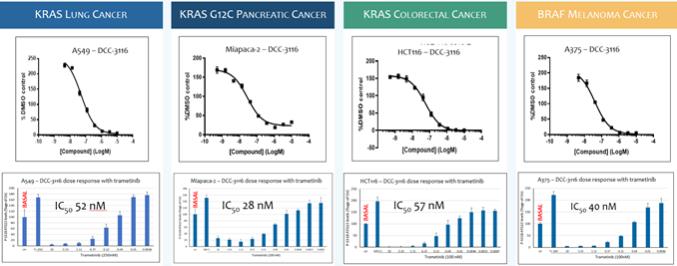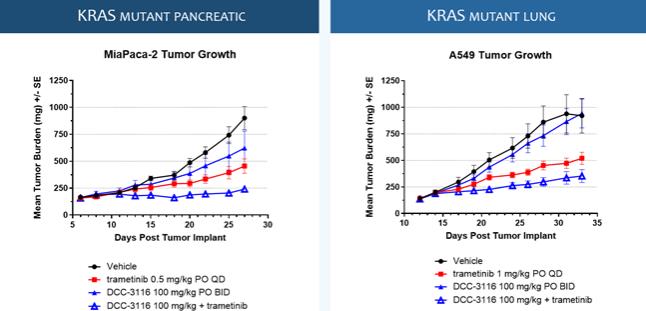Our current and anticipated future dependence upon others for the manufacture of our drug candidates or products may adversely affect our future profit margins and our ability to commercialize any products that obtain marketing approval on a timely and competitive basis.
Risks Related to Our Intellectual Property
If we are unable to obtain and maintain sufficient patent protection for our drug candidates, or if the scope of the patent protection is not sufficiently broad, third parties, including our competitors, could develop and commercialize products similar or identical to ours, and our ability to commercialize our drug candidates successfully may be adversely affected.
Our success depends in large part on our ability to protect our proprietary technologies that we believe are important to our business, including pursuing and maintaining patent protection intended to cover the composition of matter of our drug candidates, for example, ripretinib, rebastinib,DCC-3014 andDCC-3116, their methods of use, related technologies and other inventions that are important to our business. In addition to patent protection, we also rely on trade secrets to protect aspects of our business that are not amenable to, or that we do not consider appropriate for, patent protection, including our proprietary kinase switch control inhibitor platform. If we do not adequately obtain, maintain, protect or enforce our intellectual property, third parties, including our competitors, may be able to erode or negate any competitive advantage we may have, which could harm our business and ability to achieve profitability.
The patent application and approval process is expensive, time-consuming and complex. We may not be able to file and prosecute all necessary or desirable patent applications at a reasonable cost or in a timely manner. It is also possible that we fail to identify patentable aspects of our research and development output before it is too late to obtain patent protection.
Furthermore, the patent position of biotechnology and pharmaceutical companies generally is highly uncertain. No consistent policy regarding the breadth of claims allowed in biotechnology and pharmaceutical patents has emerged to date in the United States or in many foreign jurisdictions. The standards applied by the United States Patent and Trademark Office, or USPTO, and foreign patent offices in granting patents are not always applied uniformly or predictably. In addition, the determination of patent rights with respect to pharmaceutical compounds commonly involves complex legal and factual questions, which has in recent years been the subject of much litigation. As a result, the issuance, scope, validity, enforceability and commercial value of our patent rights are highly uncertain. Thus, we cannot offer any assurances about which, if any, patents will issue, the breadth of any such patents, whether any issued patents will be found invalid and unenforceable or will be threatened by third parties or whether any issued patents will effectively prevent others from commercializing competing technologies and drug candidates.
Our pending patent applications cannot be enforced against third parties practicing the technology claimed in such applications unless and until a patent issues from such applications. Assuming the other requirements for patentability are met, currently, the first to file a patent application is generally entitled to the patent. However, prior to March 16, 2013, in the United States, the first to invent was entitled to the patent. Publications of discoveries in the scientific literature often lag behind the actual discoveries, and patent applications in the United States and other jurisdictions are typically not published until 18 months after filing, or in some cases not at all. Since patent applications in the United States and most other countries are confidential for a period of time after filing, and some remain so until issued, we cannot be certain that we were the first to file or invent (prior to March 16, 2013) any patent application related to our drug candidates. In addition, we enter intonon-disclosure and confidentiality agreements with parties who have access to confidential or patentable aspects of our research and development output, such as our employees, collaborators, consultants, advisors and other third parties; however, any of these parties may breach the agreements and disclose such output before a patent application is filed, thereby jeopardizing our ability to seek patent protection. Furthermore, if third parties have filed patent applications related to our drug candidates or technology, an interference proceeding in the United States can be initiated by the USPTO or a third party to determine who was the first to invent any of the subject matter covered by the patent claims of our applications. Therefore, we cannot be certain that we were the first to make the inventions claimed in our patents or pending patent applications, or that we were the first to file for patent protection of such inventions.
Moreover, because the issuance of a patent is not conclusive as to its inventorship, scope, validity or enforceability, our patents or pending patent applications may be challenged in the courts or patent offices in the United States and abroad. There is no assurance that all of the potentially relevant prior art relating to our patents and patent applications has been found, which could be used by a third party to challenge validity of our patents, to prevent a patent from issuing from a pending patent application. For example, we may be subject to a third-party preissuance submission of prior art to the USPTO or become involved in post-grant review procedures, oppositions, derivations, revocation, reexaminations,inter partes review or interference proceedings, in the United States or elsewhere, challenging our patent rights or the patent rights of others. An adverse determination in any such challenge may result in loss of exclusivity or in our patent claims being narrowed, invalidated or held unenforceable, in whole or in part, which could limit our ability to stop others from using or commercializing similar or identical technology and products or limit the duration of the patent
48

